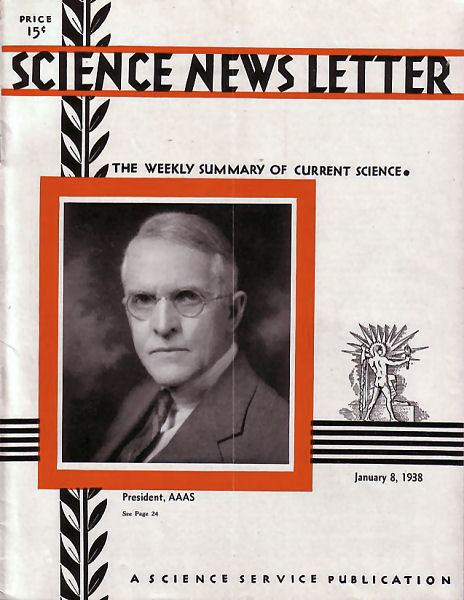From the January 8, 1938, issue

PROF. WESLEY C. MITCHELL NAMED AAAS PRESIDENT
For the first time in many years a representative of the social sciences was elected to the presidency of the American Association for the Advancement of Science when Dr. Wesley C. Mitchell was chosen to head the organization next year.
Dr. Mitchell is professor of economics at Columbia University and director of research of the National Bureau of Economics Research in New York City. He holds doctors’ degrees from the University of Chicago and Columbia.
Dr. Mitchell was born in Rushville, Ill., 63 years ago. He has gained recognition as a student of business cycles. In addition to his long career as an economist and teacher, he has served on many government technical committees. He served as chairman of the President’s Committee on Social Trends from 1929 to 1933. He was a member of the National Resources Board, 1934–35.
NEW GAS IS DISCOVERED HIGH IN ATMOSPHERE OF THE EARTH
A new and hitherto unknown atmospheric gas, a combination of oxygen and nitrogen, exists 10 to 25 miles above the Earth’s surface, Drs. Arthur Adel and C.O. Lampland of the Lowell Observatory, Flagstaff, Ariz., announced to the American Association for the Advancement of Science at the Indianapolis meeting.
It is nitrogen pentoxide, its molecule consisting of two atoms of nitrogen and five of oxygen. It is probably the rarest of gases of the air, present only in the outer regions where the ultraviolet rays of the sunlight bring oxygen and nitrogen into combination.
Existence of the new gas in the ozone layer of the atmosphere was demonstrated by delicate spectroscopy of the far infrared region of the spectrum. If the new gas existed nearer to Earth in the air around us, it would not be detectable by the most refined chemical and physical methods. Because the nitrogen pentoxide takes out certain portions of the sunlight as it comes through the atmosphere to Earth, its existence could be detected.
The situation of Lowell Observatory high on a mountain in a dry atmosphere contributed to the discovery.
BALL-AND-SOCKET JOINT FOUND IN DINOSAUR SKULL
What use was there for a ball-and-socket jointed bone at the back of a dinosaur’s skull?
Charles W. Gilmore, curator of vertebrate paleontology at the U.S. National Museum, would like to know.
At the back of the skull of a hadrosaur, a rooster-crested monster that once lived in Montana, he has found a bone arrangement that has never been found in any other kind of skull. A relatively small, triangular bone bears on its front edge a socket or cup, which fits neatly over a ball-shaped projection on the bone in front of it.
Whatever was the use of this unique skull-joint, it could hardly have been to make room for the hadrosaur’s massive brain. For the hadrosaur’s brain was anything but massive. It couldn’t have weighed more than 2 or 3 ounces. It was enough to see, hear, and probably smell with, but that was about all. But then, very likely a dinosaur never bothered to think—except possibly once in a while about another dinosaur.







